Ruppert Archaeopteryx
The Ruppert Archaeopteryx (English: ancient wing) is a Swiss high-wing, pod-and-boom, single-seat, microlift glider that was designed by Roger Ruppert and is produced by Ruppert Composite GmbH.[3][4][5]
| Archaeopteryx | |
|---|---|
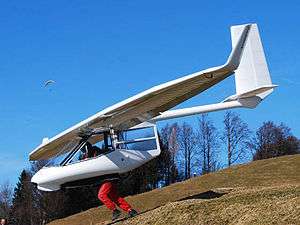 | |
| Archaeopteryx Race being footlaunched | |
| Role | Glider |
| National origin | Switzerland |
| Manufacturer | Ruppert Composite GmbH |
| Designer | Roger Ruppert |
| First flight | September 2001 |
| Introduction | 2001 |
| Status | In series production |
| Produced | 2010-present |
| Number built | 18 (February 2017)[1] |
| Unit cost |
€51,500 Standard; €57,500 Race; €72,000 Electro (2018 base prices)[2] |
The aircraft is named for the feathered Archaeopteryx dinosaur.
Design and development
The Archaeopteryx was conceived as a foot-launchable microlift sailplane, with the design goals of a light empty weight, low stall speed with gentle stall characteristics, good maneuverability and good high speed performance. A further goal was a sailplane that could be foot-launched in zero wind conditions.[3]
The Archaeopteryx design started in 1998 at the Zurich University of Applied Sciences (ZHAW) as a research project. The first flight of the initial prototype was in September 2001. Based on initial lessons the prototype was modified and reflown in May 2002. Further flight tests and modifications were carried out, with the prototype re-flying in its new form in March 2003. The production prototype design was started in 2006 and completed in 2009. The first series production started in the summer of 2009 and production deliveries to customers commenced in May 2010. By the summer of 2012 ten aircraft had been delivered to customers in Australia, Argentina, Germany, France, Austria and Switzerland.[1][4][6]
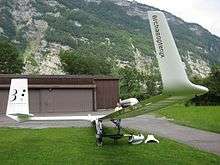
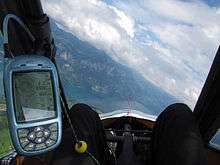
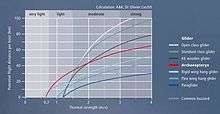
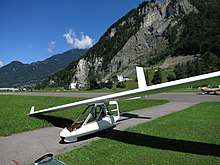
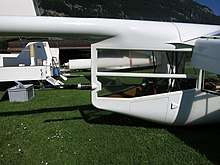
The company is developing a prototype equipped with two electric motors to provide self-launch capability.[7]
The controls are conventional, with a stick for ailerons and elevator and rudder pedals. The aircraft uses flaps for glidepath control, which function as airbrakes when set to 45-70 degrees. A ballistic parachute with an area of 62 m2 (670 sq ft) is also fitted. The aircraft can be rigged for flight by one person in 15 minutes. It has been launched by foot, aero-tow, bungee launch, auto-tow and winch-launch and has been landed on its wheel and foot-landed as well.[8][9][10][11]
The aircraft can accommodate pilots from 165 to 195 cm (65 to 77 in) in height and 55 to 100 kg (121 to 220 lb).[12]
Electric propulsion was introduced in mid-2014 and allows self-launching. A handful have been sold (and some were retrofitted to earlier sold models). Takeoff roll distance is 50 m (160 ft) and rate of climb when fully charged is 2.5 m/s (8.2 ft/s). It can run at full power for 11 minutes on one charge. The electrical motor uses 10.5 kW at 3800 rpm, and the propeller delivers 37 daN when flying at 75 km/h. Storage is a 14s1p lithium polymer battery (Kokam) with 40 Ah capacity, delivering 2.07 kWh, maximum 58.8 V and maximum continuous current of 200 amps.[13]
Variants
Specifications (Standard)
Data from Sailplane Directory, company website and flight manual[3][12][13]
General characteristics
- Crew: 1
- Length: 5.7 m (18 ft 10 in)
- Wingspan: 13.6 m (44 ft 7 in)
- Height: 2.9 m (9 ft 7 in)
- Wing area: 12.8 m2 (138 sq ft)
- Empty weight: 54 kg (119 lb)
- Gross weight: 160 kg (353 lb)
- Max takeoff weight: 191 kg (421 lb)
Performance
- Cruise speed: 57.5 km/h (35.7 mph, 31.0 kn)
- Stall speed: 30–39 km/h (19–24 mph, 16–21 kn)
- Never exceed speed: 130 km/h (81 mph, 70 kn)
- g limits: +4.0 / -2.0 at 130 km/h and +5.1 / -3.1 at 100 km/h
- Maximum glide ratio: 28:1
- Rate of sink: 0.50 m/s (98 ft/min)
Avionics
See also
Aircraft of comparable role, configuration and era
Related lists
References
- Ruppert Composite GmbH (August 2012). "plane locations". Retrieved 1 July 2016.
- "Models/Prices". Ruppert Composite GmbH. Retrieved 6 December 2018.
- Activate Media (2006). "Archaeopteryx Ruppert Composite GmbH". Archived from the original on 2 September 2012. Retrieved 25 August 2011.
- Ruppert Composite GmbH (August 2011). "Development Steps". Archived from the original on 6 October 2009. Retrieved 25 August 2011.
- Bertrand, Noel; Rene Coulon; et al: World Directory of Leisure Aviation 2003-04, page 42. Pagefast Ltd, Lancaster OK, 2003. ISSN 1368-485X
- "Development history Archaeopteryx". Ruppert-composite.ch. Retrieved 25 August 2012.
- Ruppert Composite GmbH (August 2012). "Archaeopteryx prototype electric flight". Retrieved 24 August 2012.
- Ruppert Composite GmbH (August 2011). "Control Systems". Archived from the original on 6 October 2009. Retrieved 25 August 2011.
- Ruppert Composite GmbH (August 2011). "Safety". Archived from the original on 2 February 2010. Retrieved 25 August 2011.
- Ruppert Composite GmbH (August 2011). "Rigging". Archived from the original on 6 October 2009. Retrieved 25 August 2011.
- Ruppert Composite GmbH (August 2011). "Take-off and landing". Archived from the original on 2 February 2010. Retrieved 25 August 2011.
- Ruppert Composite GmbH (August 2011). "Data". Archived from the original on 4 February 2010. Retrieved 25 August 2011.
- Flughandbuch für das Fluggerät Archaeopteryx; Version 2.2; 27 December 2016; Ruppert Composite GmbH
- Ruppert Composite GmbH (August 2011). "Versions". Archived from the original on 7 January 2010. Retrieved 25 August 2011.
- "Cockpit versions". Ruppert-composite.ch. Retrieved 25 August 2012.
- Roger Ruppert. "The electric drive system is ready!". ruppert-composite.ch. Archived from the original on 1 April 2016. Retrieved 17 May 2015.
- "Instrumentation". Ruppert-composite.ch. Retrieved 25 August 2012.
External links
| Wikimedia Commons has media related to Ruppert Archaeopteryx. |
- Official website
- Archaeopteryx foot launch at YouTube
- Archaeopteryx landing at YouTube
- Archaeopteryx Electro take-off and landing at YouTube